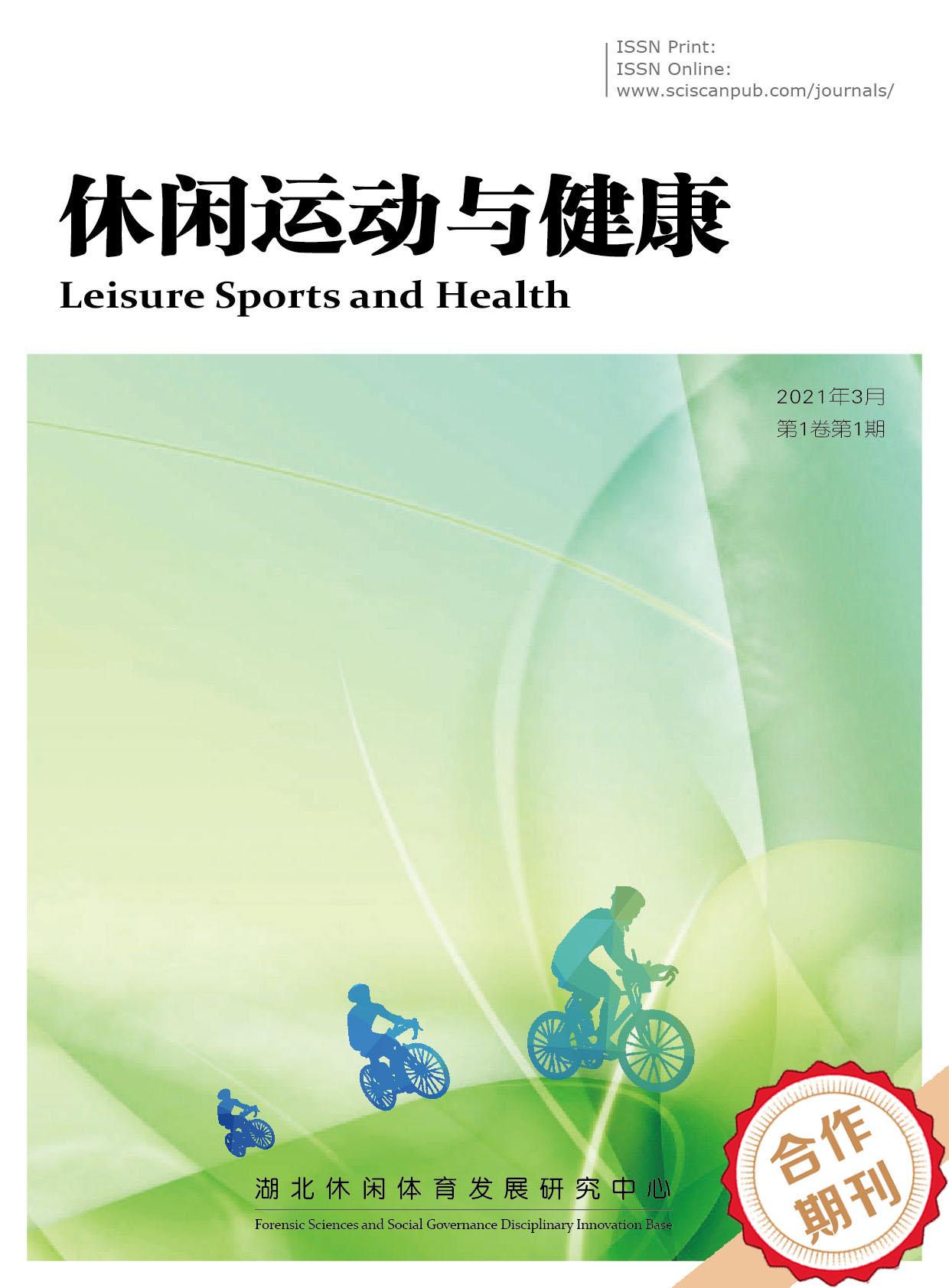Leisure Sports and Health
本体感觉精确性测量的系统性文献回顾与分析
Systematic Literature Review and Analysis of Proprioceptive Accuracy Measurement
- Authors: 朱平江
-
Information:
湖北大学体育学院,武汉
-
Keywords:
Motor control; Proprioception; Literature analysis运动控制; 本体感觉; 文献分析
- Abstract: This study primarily explores the individual’s understanding of self-body perception information, namely proprioceptive accuracy. This information originates from mechanoreceptors in various parts of the motor system and tactile receptors in the skin, providing critical evidence for assessing sensorimotor function. However, a standardized method for evaluating proprioceptive accuracy has not yet been widely accepted. This paper is a systematic study aimed at identifying and classifying different methods for assessing various aspects of proprioceptive accuracy. We conducted literature searches in multiple domestic and international databases, including Wan Fang, VIP, Baidu Scholar, SCIE, PubMed, SPORTD iscus, Science Direct, and SpringerLink. The results show that we retrieved 1,386 scientific papers, from which 739 were eliminated after screening, ultimately including 647. These cover eight different aspects of proprioception: joint position sense, movement and range of motion perception, trajectory perception, speed perception, force level perception, muscle tension perception, weight perception, and object size perception. These methods employed three psychophysical approaches: variable adjustment measurement, constant measurement, and threshold measurement. However, the results for different body parts were unrelated to different tasks, indicating that proprioceptive accuracy is site-specific and method-specific. Therefore, appropriate measurement methods need to be chosen based on theoretical considerations and ecological validity. 本研究主要探讨了个体对自身体感信息的理解能力,即本体感觉精度。这些信息源自运动系统各部位的机械感受器及皮肤的触觉感受器,为评估感觉运动功能提供关键依据。然而,评估本体感觉精度的标准方法目前尚未被广泛接纳。本文是一项系统性研究,旨在识别并分类评估本体感觉精度各方面的不同方法。在国内外多个数据库中进行文献检索,包括万方、维普、百度学术、SCIE、PubMed、SPORTDiscus、ScienceDirect和SpringerLink等。结果显示,检索到1386篇科学论文,经过筛选后剔除了739篇,最终收录了647篇。涵盖了本体感觉的8个不同方面:关节位置感知、运动及运动范围感知、轨迹感知、速度感知、力量水平感知、肌肉紧张感知、重量感知以及物体大小感知。采用了三种心理物理学的方法:变量调节测量、恒定测量以及极限值测量。但不同任务对不同身体部位的结果并无关联,即本体感觉精度具有部位特异性和方法特异性,因此需要基于理论考虑和生态效度选择合适的测量方法。
- DOI: https://doi.org/10.35534/lsh.0402003
- Cite: 朱平江.本体感觉精确性测量的系统性文献回顾与分析[J].休闲运动与健康,2024,4(2):11-16.
1 引言
运动控制离不开本体感觉信息的精确度,这些信息源自运动系统内部的机械感受器[1]。如肌梭和Golgi腱器官负责传达有关肌肉长度、拉伸速率、紧张度和肌肉收缩力的信息[2]。皮肤、韧带及关节囊内的感受器,如帕西尼氏、鲁菲尼和麦斯纳小体,对感知本体信号至关重要[3]。正常发育的人类能够自动处理、整合并自觉感知来自本体感觉的信息,并将其用于目标导向的运动行为[4]。本体感觉准确性是指个体感知本体感觉信息的能力,对于运动控制和表现至关重要[5]。研究表明,本体感觉准确性与体育成就密切相关,且与受伤风险成反比[8]。随着年龄的增长,本体感觉准确性会下降并导致跌倒风险增加。通过体育活动可以改善本体感觉准确性,抵消年龄增长带来的负面影响[6]。为了评估感觉运动功能以及评估不同干预措施的效果,目前国内外已经开发出多种测量本体感觉准确性的方法[7]。这些方法包括关节位置检测、被动运动检测和被动运动方向辨别等[9],已有的部分研究还开发了基于心理物理实验的经典方法,如关节位置再现测试、主动运动范围辨别评估和被动运动检测阈值等[10],然而,现有综述对本体感觉的定义相对狭窄,只涵盖了部分方法[4]。本文的主要目标是识别和分类评估本体感觉准确性,包括关节位置、运动和运动范围、力量和重力感知等各个方面[11,12],以全面识别和分类用于测量本体感觉准确性的方法和技术,为从业者和科学研究提供更多参考。
2 研究方法
本文通过在万方、维普、百度学术、SCIE、PubMed、SPORT Discus、Science Direct和SpringerLink等不同的数据库中,检索了近10年的文献摘要和标题。文献筛选阅读的标题和摘要,做出初步的判断,当文献不符合筛选标准时被剔除。
表 1 文献筛选标准
| 关键词 | 中文关键词:本体感觉并包含有准确性、敏锐度、敏感性、能力、运动辨别、运动检测、关节位置感、运动感知等关键词 |
| 英文关键词:propriocept和accuracy、acuity、sensibility、sensitivity、movement discrimination、movement detection、joint position sense、movement perception等关键词 | |
| 数据库 | 万方、维普、百度学术、SCIE、PubMed、SPORT Discus、Science Direct和SpringerLink |
| 文献类型 | 实验类论文 |
| 纳入标准 | 受试人群:不筛选 |
| 干预措施:不筛选 | |
| 对照组:不筛选 | |
| 结果筛选:关于本体感知准确性的客观测量 | |
| 排除标准 | 学位论文、文献综述、会议资料,非中、英文文献 |
3 研究结果
3.1 文献纳入
数据库搜索共识别出1386篇文献。在去除重复项后剩余1251篇。之后进行文献的摘要筛选,剔除了130项研究。最后纳入研究的文献数量为647篇。在许多论文中,同一样本使用了多种评估本体感知准确性的方法。之后根据测量方法和测量技术进行了分类,使用两个主要标准来分类方法:评估了本体感知准确性的哪些方面,以及应用了哪种心理物理学方法。具体为:(1)变量调节测量:参与者必须调整刺激水平以达到参考标准;(2)恒定测量:包括恒定刺激方法,参与者必须判断成对呈现的标准和比较刺激,以及单刺激方法,参与者判断单独呈现的单个刺激;(3)极限值测量:参与者必须指出刺激的出现或消失。

图 1 文献筛选流程
3.2 本体感知准确性测量技术
1)变量调节测量
通过对文献内容进行详细分析,被纳入研究并使用变量调节测量的文献中,包含了八种不同类型的本体感觉精确度测量技术。
关节位置再现:参与者身体中的一个或多个关节被移动到目标位置后,尽可能准确地再现这些关节的位置。在此过程中,关节的移动可以是主动或被动的,位置的重复可能发生在同一关节或对侧关节[13]。
指向性本体感受:身体的一个部位被设定到目标位置。参与者必须尽可能准确地指向或到达该身体部位的位置[14]。
运动轨迹再现:身体的一个部位沿着给定的轨迹,以给定的速度移动到给定的终点。参与者需要尽可能准确地再现运动的轨迹、速度和终点。
轨迹再现:身体的一个部位沿着给定的轨迹移动。参与者需要再现运动的轨迹[19]。这可以在同一关节或对侧关节上进行。
速度再现:身体的一个部位被设定以给定的速度移动。参与者的任务是使用同一或对侧身体部位再现相同的速度。
水平力量再现:参与者被引导使用肌肉或肌肉群产生一定水平的力。在产生后,他们需要使用同一或对侧肌肉再现相同的力。
水平维持力水平再现:参与者需要产生一定量的(非最大)力,并保持其在同一水平[16]。
肌肉紧张度再现:被试者被要求使用肌肉或肌肉群产生给定水平的肌肉紧张度。在产生后,他们需要尽可能准确地再现相同的肌肉紧张度水平[15]。
2)恒定测量
文献中包含了基于恒定测量的六种不同的本体感觉精确度测量技术。
关节位置辨别:参与者需要比较两个关节位置,并决定它们是否相同或不同(主动运动范围辨别装置,在每次试验中呈现单一刺激供判断)[19]。
运动辨别:参与者需要比较两个运动(具有给定的轨迹、速度和终点),并决定它们是否相同或不同。
速度辨别:参与者需要执行两个运动速度,并决定它们是否相同或不同[16]。
力量辨别:参与者需要两次产生给定水平的力,并决定这两次产生的力是否相同或不同。
重量辨别:参与者被呈现两个物体,并需要决定这两个物体的重量是否相同或不同。
大小辨别:参与者被呈现两个物体,并需要决定这两个物体的大小是否相同或不同[16,17]。
3)极限值测量
文献中包含了基于极限值测量的一种本体感觉精确度测量技术。
被动运动检测阈值:参与者身体的一个部位被动地移动,在感知到位移时立即给出信号。这种方式基于上升和极限(即刺激水平逐渐增加直到被感知),目前没有文献使用下降极限法(即刺激水平逐渐降低直到被感知)来评估本体感觉精确度的案例[16]。
表 2 本体感觉准确度测量技术和方法
| 本体感觉测量技术 | 调整测量 | 恒定测量 | 极限测量 |
| 关节位置感知 | 关节位置再现,指向本体感觉目标 | 关节位置辨别 | 被动运动检测阈值 |
| 运动及运动范围感知 | 运动再现 | 运动辨别 | 无 |
| 轨迹感知 | 轨迹再现 | 不适用 | 无 |
| 速度感知 | 速度再现 | 速度辨别 | 无 |
| 力量水平感知 | 力量再现,水平力量以及水平力量的保持 | 力量辨别 | 不适用 |
| 肌肉紧张感知 | 肌肉紧张度再现 | 不适用 | 不适用 |
| 重量感知 | 不适用 | 重量辨别 | 不适用 |
| 物体大小感知 | 不适用 | 大小辨别 | 不适用 |
4 讨论
本文对当前用于评估本体感觉准确性的方法和技术进行了整理与分类,明确了本体感觉的八个关键维度:包括关节位置感知、运动及运动范围感知、轨迹感知、速度感知、力量水平感知、肌肉紧张度感知、重量感知以及基于本体感觉信息的物体大小感知[4]。这些维度可通过心理物理学的传统方法,如变量调节测量、恒定测量和极限值测量等进行量化。本体感觉准确性评估方法具有多样化的特点,但文献中普遍认为通过某一特定方法针对某一特定身体部位(如关节、肌肉)所得出的结果具有普遍适用性[1]。这种假设暗含了一种可推广的本体感觉准确性测量,那么在不同测试和不同身体部位之间获得的结果应当显示出相关性,在某一特定测试(如关节位置再现)中针对某一特定身体部位(如肘部)表现最佳的个体,在另一测试(如被动运动检测阈值)评估另一部位(如膝盖)时也应表现出最佳状态。然而,实证研究并未证实这种强烈关联的存在[27],且本体感觉准确性展现出明显的部位特异性和方法特异性[33]。
表3汇总了同一实验下不同测试指标,这些指标在报告中不具备显著的相关性,这说明本体感觉的准确性是具有部位特异性和方法特异性的,意味着人体对不同身体部位的动作和位置感知的准确性,可能因所用的测试方法和测试部位的不同而有所不同[29,30]。国外有研究表示,职业舞蹈员在关节位置再现测试中的表现不如对照组,但在与膝盖关节本体感觉准确性紧密相关的被动运动检测阈值测试中,却表现出色[22]。力量再现测试与踝关节不稳定指数和踝关节刚度之间的关联,而非关节位置再现测试,进一步强调了本体感觉准确性的部位特异性[25]。在压迫性神经病变的研究中,验证了功能障碍只与通过关节位置再现测试测量的本体感觉精确度有显著关联,而与被动运动检测阈值测试所测量的精确度无明显关系。虽然实验引入的疼痛条件显著影响了被动运动检测阈值的测试结果,但却未对JPR测试中的表现产生影响,从而强调了不同本体感觉测试的特异性[26]。进一步说明了即使在同一部位内,不同关节之间的JPR测试相关性并不明显。即便在同一测试和同一关节内,可能因肢体移动速度的不同而不存在相关性。在本体感觉测试中,那些有功能性踝关节不稳定的人显示出位置特定的准确性缺陷,表明本体感觉精确度可能不仅具有部位特异性,还可能具有位置特异性[27]。另外,本体感觉准确性评估的评分方法选取是一项关键且复杂的任务,多数测试提供多种评分选项,每种选项都旨在揭示被试者表现的不同方面[31]。例如,变量调节测试允许通过三种不同的指标进行评估:绝对误差、常数误差和变异误差。绝对误差衡量参考刺激与再现刺激之间的平均绝对差异,反映了被试者在位置判断上的整体精确性;常数误差考察有符号的差异,揭示了判断中的系统性偏差;变异误差为误差分数的标准偏差,反映了被试者表现的一致性。恒定测试则提供敏感性和特异性指标,以及最小可辨差异作为评分选项[31]。敏感性指数测量在刺激存在差异时被试者正确判断的比例,特异性指数则是在两个刺激相同时正确判断的比例;而最小可辨差异标示了被试者可以在至少50%的时间里感知到的最小差异值[20]。目前学术界尚无共识决定哪种评分方式最为合适,不同的研究可能会选择不同的评分标准,且不同评分指数之间的相关性研究较少,这使得研究结果间难以进行比较。因此,建立统一的评分标准和报告指南对于本体感觉研究的发展,以及提高研究结果的可比性是至关重要的[29]。
表 3 本体感觉测量技术不同测试之间关系的研究
| 作者 | 研究指标 |
| Grob et al.[27] | 关节位置再现,被动运动检测阈值 |
| Janwantanakul et al.[28] | 关节位置再现,被动运动检测阈值 |
| de Jong et al.[29] | 关节位置辨别,被动运动检测阈值 |
| Elangovan et al.[30] | 关节位置辨别,关节位置再现 |
| Li et al.[31] | 关节位置再现,被动运动检测阈值,力量再现 |
| Nagai et al.[32] | 关节位置再现,速度再现,被动运动检测阈值,力量再现 |
| Niespodzinski et al.[33] | 关节位置再现,力量再现 |
| Yang et al.[34] | 运动辨别,关节位置再现 |
| Horvath et al[21] | 关节位置再现,重量辨别 |
5 结论与建议
综上所述,检验的特异性和特定部位的特异性以及对于如何为这些测试评分的共识缺乏,导致在研究中说明本体感觉准确性时都需要明确指出所采用的特定评估工具、评分标准以及所涉及的关节。然而,本体感觉准确性并不能单纯通过一个测试来全面评定,因此选择最贴合当前研究要求或具体实践问题的评估方法显得尤为重要。寻找评估本体感觉准确性的最优方法可能是未来研究的关键任务。在运动控制的复杂过程中,输入与输出环节之间的相互作用密不可分。主动运动过程中,肌梭等感受器的传入反馈与运动命令的传出信息交织在一起,共同完成运动的精确性。已有的研究证明,主动肌肉活动的增强会提升个体的运动准确性[18]。从外部效度来看,涉及主动运动的测试更好地反映了个人在日常情况下的表现。测试方法的选择要考虑到由于某些运动障碍而无法移动肢体或关节到特定位置(例如,单侧中风患者的受影响的上肢或下肢[16]),否则这将极大地影响本体感觉准确性测试的结果。因此在选择测试方法和技术时,应仔细考虑是在同侧关节还是对侧关节[23]。同侧关节测试依赖于记忆能力,而对侧关节测试则涉及半球间的信息转移[24]。除了本体感觉信号的处理能力之外,其他相关的能力和特征,如记忆、半球间转移以及肢体优势性,都可能在测量过程中扮演重要角色而影响最终的表现[18]。在设计和选择本体感觉准确性测试时,这些因素都应被纳入考量范围,以确保测试的准确性和适用性。
参考文献
[1] L B R,M S L.The Sensorimotor System,Part II:The Role of Proprioception in Motor Control and Functional Joint Stability[J].Journal of athletic training,2002,37(1):80-4.
[2] Han J,Waddington G,Adams R,et al. Assessing proprioception:A critical review of methods[J].Journal of Sport and Health Science,2016,5(1):80-90.
[3] Han J,Waddington G,Anson J,et al.Level of competitive success achieved by elite athletes and multi-joint proprioceptive ability[J].Journal of Science and Medicine in Sport,2015,18(1):77-81.
[4] Violaine S,Christophe B.On the Role of Proprioception in Making Free Throws in Basketball[J].Research quarterly for exercise and sport,2015,86(3):274-80.
[5] 王雨生,李晓,展嘉文,等.本体感觉训练对单侧全膝关节置换术后站立姿势稳定性和步态功能的影响[J].中国骨与关节杂志,2024,13(4):245-252.
[6] 王蕊,付文婷,常玉春.本体感觉训练对老年类风湿性关节炎患者自我效能水平、关节疼痛及运动能力的影响[J].数理医药学杂志,2022,35(10):1482-1484.
[7] 周骏捷,常凤.基于知识图谱的我国本体感觉训练可视化分析[C]//中国体育科学学会.第十二届全国体育科学大会论文摘要汇编——专题报告(体质与健康分会).湖北大学体育学院,2022:3.
[8] 陈玉潇,刘姣姣,伊长松,等.本体感觉训练对运动员踝关节扭伤康复效果Meta分析[J].康复学报,2020,30(6):489-496.
[9] Hams A,Evans K,Adams R,et al.Throwing performance in water polo is related to in-water shoulder proprioception[J].Journal of Science and Medicine in Sport,2019,22(Supl.2):S39-S40.
[10] Cameron M,Adams R,Maher C.Motor control and strength as predictors of hamstring injury in elite players of Australian football[J].Physical Therapy in Sport,2003,4(4):159-166.
[11] Wingert R J,Welder C,Foo P.Age-Related Hip Proprioception Declines:Effects on Postural Sway and Dynamic Balance[J].Archives of Physical Medicine and Rehabilitation,2014,95(2):253-261.
[12] Ribeiro F,Oliveira J.Aging effects on joint proprioception:the role of physical activity in proprioception preservation[J].European Review of Aging and Physical Activity,2007,4(2):71-76.
[13] Aman E J,Aman E J,EElangovan N,et al.The effectiveness of proprioceptive training for improving motor function:a systematic review[J].Frontiers in Human Neuroscience,2015,81075.
[14] Hoang D P.Fall risk in people with MS:A Physiological Profile Assessment study[J].Multiple Sclerosis Journal - Experimental,Translational and Clinical,2016:292-100.
[15] 冯亮,张雅飞,霍洪峰.足踝复合体本体感觉的测量与评价[J].中国组织工程研究,2024,28(20):3259-3264.
[16] 陈泽华,叶翔凌,陈伟健,等.健康成年人下肢本体感觉与姿势稳定性的关系[J].中国组织工程研究,2020,24(29):4692-4696.
[17] 冯洁,任杰.体育运动中的意识与无意识本体感觉[J].体育科研,2017,38(4):61-67.
[18] 杨念恩,李世昌,黄文英,等.本体感觉差异性特点及其神经机制研究[J].体育科学,2014,34(4):41-48.
[19] Sole G,Osborne H ,Wassinger C.The effect of experimentally-induced subacromial pain on proprioception[J].Manual Therapy,2015,20(1):166-170.
[20] Nili S,Roger A,Moshe A,et al.Recent ankle injury,sport participation level and tests of proprioception[J].Journal of sport rehabilitation,2018,28(8):1-25.
[21] D C M.Sensorimotor anatomy of gait,balance,and falls[J].Handbook of clinical neurology,2018:1593-26,56.
[22] R T M,T B P,J S W,et al.Developing Proprioceptive Countermeasures to Mitigate Postural and Locomotor Control Deficits After Long-Duration Spaceflight[J].Frontiers in Systems Neuroscience,2021:15658985-658985.
[23] 马晓丽,马小远,宋祺鹏.高运动需求者前交叉韧带重建术后不同时期的肌肉力量、本体感觉和足底触觉与重返运动的相关性研究[J].中国康复医学杂志,2023,38(9):1207-1213.
[24] 张鑫,刘波.关节本体感觉测试训练仪的研制与初步应用[J].中国运动医学杂志,2017,36(1):56-58.
[25] Lina A R,Evi P,Dominique R,et al.Validity and Reliability of an Inertial Sensor-Based Knee Proprioception Test in Younger vs.Older Adults[J].Frontiers in Sports and Active Living,2019:127-27.
[26] Grob K R,et al.Lack of correlation between different measurements of proprioception in the knee[J].The Journal of bone and joint surgery. British volume,2002,84(4):614-8.
[27] Janwantanakul P,Magarey E M,Jones A M,et al.The effect of body orientation on shoulder proprioception[J].Physical Therapy in Sport,2003,4(2):67-73.
[28] ]Jong D A,Kilbreath L S,Refshauge M K,et al.Performance in Different Proprioceptive Tests Does Not Correlate in Ankles With Recurrent Sprain[J].Archives of Physical Medicine and Rehabilitation,2005,86(11):2101-2105.
[29] Naveen E,Amanda H,Jürgen K.Assessing proprioceptive function:evaluating joint position matching methods against psychophysical thresholds.[J].Physical therapy,2014,94(4):553-61.
[30] Li L,Ji Z,Li Y, et al.Correlation study of knee joint proprioception test results using common testmethods[J].Journal of Physical Therapy Science,2016,28(2):478-482.
[31] Barış S,Ali Z,Deran O.Comparison of the validity and reliability of three different methods used for wrist proprioception measurement[J].Journal of Bodywork Movement Therapies,2024,37170-176.
[32] Bartłomiej N,Andrzej K,Jan M,et al.Relationship between Joint Position Sense,Force Sense,and Muscle Strength and the Impact of Gymnastic Training on Proprioception[J].BioMed research international,2018,20185353242.
[33] Nan Y,Gordon W,Roger A,et al.Joint position reproduction and joint position discrimination at the ankle are not related[J].Somatosensory motor research,2020,37(2):97-105.
[34] Áron H,Luca V,Eszter F,et al.Cardiac and Proprioceptive Accuracy Are Not Related to Body Awareness,Perceived Body Competence,and Affect[J].Frontiers in Psychology,2021:11575574-575574.
















